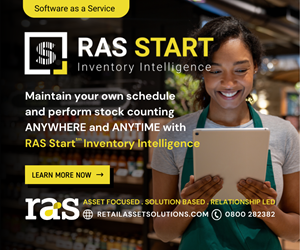Industry Focus
How Does D&I Become Part of the DNA?
Can Greater Diversity Help Reverse the Great Resignation?
Retail recruitment and retention are in reverse, but is the UK’s largest private employer “resigned to the Great Resignation” that saw 650,000 leave the sector over the last two-and-a-half years? Or are employers determined to arrest the attrition caused by the effects of a form of attitudinal-long COVID—a corrosive legacy of low morale resulting from the pandemic and its associated mental health challenges, the all-consuming cost-of-living crisis, and the prolonged exposure to industrial levels of violence and abuse in their frontline roles?
In 2020, the number of people employed in retail was 3.1 million, but the COVID-19 driven sector exodus has seen colleagues quit in large swathes. The latest figures from the Office for National Statistics showed a drop of 83,000 in the last twelve months.
In its 2022 Health of Retail report, the Retail Trust reported that a fifth of staff plan to leave the industry, a charge predominantly led by younger workers who make up a large percentage of the entire workforce, the so-called Gen Z or “Zoomers” who, according to Deloitte’s 2022 Global Generation Z and Millennial Survey, across forty-six countries, are defined as those individuals who see “Diversity as their norm, are our first ‘digital natives,’ are pragmatic and financially minded, politically progressive, and shrewd consumers.”
Disconnect Between Employees and Employers
Diversity and the need to recognise themselves represented at all levels of an organisation are important drivers in recruitment and retention of this particular cohort.
Ali Hannon, a leading equality, diversity, and inclusion (EDI) consultant, argues that the sector has the perfect opportunity to showcase diversity by reflecting the wider society that it serves by openly embracing a proactive and honest approach to inclusion across retail.
“Today’s Generation Z is looking for organisations to live up to the very high standards they have for themselves when it comes to social issues like gender, race, disability, neurodivergence, and intersectionality,” said Ali, a motivational speaker and business mentor.
In 2020, at the height of the pandemic, the British Retail Consortium published its annual Diversity and Inclusion in UK Retail: Where We Are and What Comes Next that highlighted that although 89 per cent of retailers were forming D&I strategies, only 47 per cent of employees felt that they were effectively communicated.
Indeed, the report, written in conjunction with accountants PwC and executive recruiters The MBS Group, found that only half of employees believed that D&I was high on their boss’s agenda.
Tellingly, the report said 100 per cent of D&I strategies were gender specific with 90 per cent also including race and ethnicity, while 68 per cent also focussed upon LGBTQI+ inclusivity.
Two years on, the 2022 edition of the same report showed some upward movement on the numbers. Most companies (91%) now have a co-ordinated D&I strategy, and these were more “broad-reaching” than last year with many more including disability (78% in 2022 versus 50% in 2021) and social mobility (59% in 2022 versus 20% in 2021).
However, the report cautioned that despite these improvements there is little or no progress on gender diversity at senior levels and that although ethnic diversity has increased, momentum in this area has also slowed.
Data collection around overall diversity is also “incomplete.” This means that although employee engagement surveys are more comprehensive than previous years, including questions on disability, social mobility, LGBTQ+, and mental health, most of the intelligence is focussed on diversity outcomes rather than employee engagement and inclusion—how employees actually feel.
Here, there remains an attitudinal chasm and an awkwardness around talking about D&I for fear of offending sensibilities or “mis-gendering” non-binary employees, for example—a silence that can compound an already high-churn employment rate that is not good for the individuals, the wider business, or the sector.
“There’s a lot for leaders to get their heads around and fear of getting this all wrong is holding the wider conversation back,” added Ali.
One cannot also simply talk about retail in general as certain departments may face different challenges. The retail security industry, for example, retains the reputation of being a safe bastion for traditionally male former Police officers whose driving KPI has traditionally been “feeling the collars” of shoplifters. Although there are now more women in security and greater diversity of entrants through a number of retailer-driven apprenticeship schemes—and even offender programmes to provide career opportunities in LP and profit protection—the legacy remains.
Security Workforce by the Numbers
In 2021, Anna-Liisa Tampuu and Lisa Reilly, the co-chairs of the Security Institute’s Inclusive Security Special Interest Group (ISSIG), launched an inclusion and diversity questionnaire, aiming to understand the sector’s workforce in greater detail. It addressed demographic categories including, but not limited to, age, ethnicity, sexual orientation, educational background, and gender, as well as visible and non-visible disabilities.
The preliminary findings of the survey recorded a low representation of women in the security sector, with 77.7 per cent of the 655 respondents identifying as male, 82.1 per cent of respondents identifying as white, and 63.6 percent aged over forty-five. The survey also revealed that 88 per cent identified as heterosexual; 8.3 per cent as gay, lesbian, bisexual, asexual, pansexual, or queer; while 2.7 per cent preferred not to complete that section.
In the qualitative part of research undertaken with the survey by Enyioma Anaba’s Driving Diversity and Inclusion Within the Security Industry in the UK, respondents were asked how safe they felt at work. All within the minority ethnic, gender, and sexual orientation groups, excluding the mixed-race participants, stated they felt unsafe, highlighting that stereotypes and unconscious bias contribute to this. Indeed, all respondents within the LGBTQI+ community reported making individual adjustments to feel safe.
In their report, they say: “Inclusion is creating an exciting and safe workplace that encourages differences and sees the innovation value of the whole team, and all staff want to stay. As women, we have experienced discrimination in the sector and, unfortunately, know others who have left the sector as they were never made to feel safe or part of ‘the team.’ This is equally applicable for ethnicities and other ‘different’ personal profiles.
“Going forward, how can the security industry create positive change and lead with inclusion to attract and retain talent and foster innovation? As a sector, it’s our responsibility to ensure that the workforce of security professionals reflects the people whom we serve to protect. This is currently not the case. Therefore, if we are going to attract the next generation into the sector, it is important to raise awareness about the variety of opportunities available. A diversity of viewpoints and backgrounds will mean that, as a sector, we are best prepared to tackle the threats of both today and tomorrow.
“The industry needs to create a physically and psychologically safe space for all individuals, regardless of their background and personal profile, to thrive and have the opportunity to achieve their potential, free from prejudice and discrimination. This is about inclusive leadership and management, active listening and stepping out of our comfort zone. We must all have the curiosity to learn about and from others and must understand that every individual has their unique story and gifts, shaped by countless factors—background, origin, gender, religion, education, socio-economic background and lived experiences.”
We Are All Finding Our Own Way
This was one of the key themes at October’s Retail Risk conference in Leicester, where a panel discussion on diversity and inclusion attracted wide interest. Facilitated by Ali Hannon, panel members included Iona Blake from Boots, Raj Chadha from TSS, and V. Wilkes, global head of security at Primark, who has a career spanning more than twenty years in the sector.
“We are all finding our own way and dealing with our own growth. We cannot underestimate the responsibility and role of employers in enabling and supporting every colleague to be their true selves in the workplace,” said V.
“I’m always excited to learn and hungry to develop. To make security fit for the future, I believe in building a clear strategy while constantly innovating, progressing, listening, and supporting ideas that drive the business forward. My career path in the security industry has been an amazing journey for me.”
Although diversity and inclusivity has become a major issue for many businesses, it has also attracted high-profile headlines in the popular media as part of a sometimes politicised debate that has fuelled what was referred to earlier on as “the fear about saying the wrong thing” and attracting the wrong kind of headlines.
V. Wilkes, who came out as non-binary around a year ago, contributed to a Primark blog to demystify the issue. “It is well understood that non-binary is an umbrella term for gender identities that fall outside the gender binary of male or female. This includes individuals whose gender identity is neither exclusively male or female, a combination of male and female, or between or beyond genders.
“I came out to my family, close friends, and work colleagues around twelve months ago. However, I identified as non-binary a few years before this to my wider network.
“Pronouns are words we often use to refer to a person when we don’t use their name. Gender specific pronouns ‘he’ and ‘she’ are generally used for men and women. But some people prefer to use ‘they/them’ pronouns, for example, if they identify as non-binary.
“For me, as a non-binary person, the reason pronouns are important is that often people make assumptions about the gender of another person based on the person’s appearance or name. These assumptions are not always correct, and by assuming (even if you are correct), it sends a message that people must look, act, or present in a certain way to demonstrate the gender that they are or are not. When someone is asking you to use their pronouns, they are asking for you to respect their identity.
“I work in security, which is typically male dominated, but I’m pleased to say that, for the most part, my peers have been very accepting and open-minded, which is something that gives me huge reassurance. As humans, we all need to feel a sense of belonging and acceptance. To have the support of peers in my industry means an awful lot to me.
“Of course, there are a handful of people who still question my identity and can’t see beyond the binary construct, and they are very vocal about their opinions, which can be hurtful. But I hope in time I will be able to disregard their opinion and not let it bother me.”
Golf enthusiast V. likes to have a clear view of the fairway, and this is reflected in their management style, which is to empower rather than micro-manage colleagues in their roles.
“It is important that people are heard and have a voice, and I am elated when my team helps to come up with the strategy. I am passionate about what is my dream job, and I hope my visibility is good for other people to show that they too can be successful,” said V.
“Asking curious and respectful questions, reading books, and using other resources that will help you better understand diverse communities in your workplace will help us to get over this fear. We need to learn to embrace the discomfort of talking about and tackling tough issues regarding diversity. The best approach is to be curious and respectful and apologise if you make a mistake so you can learn from it and move on. You’re far less likely to offend anyone if you show a little respect. Avoiding the conversation will only hold us back, and we won’t ever be able to tap into the strength that diversity brings or create inclusive environments for everyone around us.
“Leaders need to create a culture of diversity and inclusion and educate all staff appropriately in D&I. We don’t know what we don’t know—we all have different experiences and must be open to learning about the experiences of others to understand what diversity and inclusion truly means.
“The best way to understand where the opportunities for improvement lie is to ask colleagues for their input, so that together you can identify areas where you can make a real impact in the workplace.
“It’s important that we are aware of indirect discrimination and prevent unconscious biases creeping into our decision making, actions, and behaviours. We’re all guilty of this, no exceptions, but through education and training we can understand our individual biases and catch ourselves in the moment.
“We also can’t underestimate the role of allies. Allies are vital and welcomed supporters of the LGBTQI+ community, as they have powerful and influential voices. Having allies helps to create a platform to fight homophobia and transphobia, and they personally advocate for equal treatment for all people, regardless of their sexual orientation, etc.”
At Boots, Inclusion Is a Core Value
Unfortunately, discriminatory language and behaviour based upon ignorance and assumptions do still occur, as has been the experience of those helping to set the agenda on diversity. Iona Blake, security and incident manager for Boots, has experienced first-hand inappropriate comments made at an industry event within the security and LP sector.
“It was a very inappropriate comment made by someone who should have known better. It made me think—I can’t believe they said what they said. They’d had too much to drink, but that is no excuse—I had to call them out on it,” said Iona, whose championing of diversity issues stems from being bullied at school because of a genetic hearing impairment.
“Indeed, from that moment onward, I felt there was a real educational opportunity here, which was why I was delighted to become involved with the Retail Risk panel discussion because the reality is that we work in teams where diversity is our strength. This is very much what we are at Boots—inclusion is amongst our core values and it’s important to represent the community that we’re serving and protecting—D&I is part of our DNA.”
Within Boots, there are a number of what are called Business Resource Groups (BRG) that are formed along a dimension of diversity such as age, gender, race/ethnicity, sexual orientation, gender identity, disability, or veteran status; a corporate social responsibility focus such as environmental sustainability; or business division or function such as information technology. The BRGs create opportunities for team members to build connections and learn from each other, as well as provide opportunities to recommend policy or practice changes to foster greater workplace inclusion.
Iona added, “It’s all about how we at Boots manage situations in a sensitive and appropriate manner. The BRGs are there to help us all hold ourselves to account. For example, you can be diverse, but that does not necessarily mean that you are inclusive, which is one of the messages I wanted to get across during the Retail Risk panel discussion.
“Personally, speaking as someone with a hearing impairment, I have learned to lip-read as my superpower, but on a wider point, this has taught me to give my full attention to the person in front of me.”
Nurturing Talent at TSS
Raj Chadha, the CEO of Total Security Services (TSS), said, “Diversity and inclusion is important if we are to leverage the true talent of a workforce. It’s about an industry going through change and need for new blood and ideas.”
A Sikh who began his career fixing computers at the business that he now runs, Raj talks passionately about challenging the status quo and how being open to open-mindedness was key to change. “You have to be secure in your abilities in the first place and appreciate the diversity of other people to make an enterprise grow—from grassroots talent upward.
“I was lucky, I went to a good school and was able to get on with people. I spoke English there and Punjabi at home, but I never necessarily saw myself as different. It’s been a really interesting journey, and I have had the time of my life.”
He added. “Many people see security as a stop-gap job, but it is our job to retain people and help them grow and progress.”
Ali Hannon, who uses comedy as part of their D&I leadership training, added, “Tradition can hold us back if we’re not really careful. We don’t want to get caught out by the idea that just because something has always been the case that it needs to be in the future. Inclusion is ever-evolving, and it’s up to leaders to keep listening and keep learning, and not expect a clear end point. The rate of change is pretty staggering at times!”
Ali explained, “It is all about feeling valued as an individual—it is okay to be different. There is a lifetime of conditioning we have to get through. It is no longer binary men and women in security, but it is all pushing our understanding of wider teams.
“Success can also mean the freedom to disclose more because you feel part of an environment where this is encouraged—you feel safe to talk about who you really are. Success can also be measured in terms of reducing staff turnover—no one should leave an organisation without fulfilling their full potential. In leaving, they are saying that there is something missing. This is why exit interviews are always interesting.
“If an organisation can listen and develop a culture of D&I early in their growth, then an inclusive culture can develop with an organisation, so it’s good to get serious about culture even when a business is small. Change does not happen overnight—it’s no tick box exercise with quick results,” added Ali.
While recruitment in retail remains perilous, the industry is having the difficult and necessary conversations to reverse years of cultural assumptions that have for too long been holding the sector back. If the sector is to flourish and grow, it has to embrace D&I as part of its DNA. Retail is the shop window on society, where successful businesses employ colleagues who mirror and reflect the customers that they serve, rather than clinging to stereotypical roles that are ultimately divisive rather than diverse.






